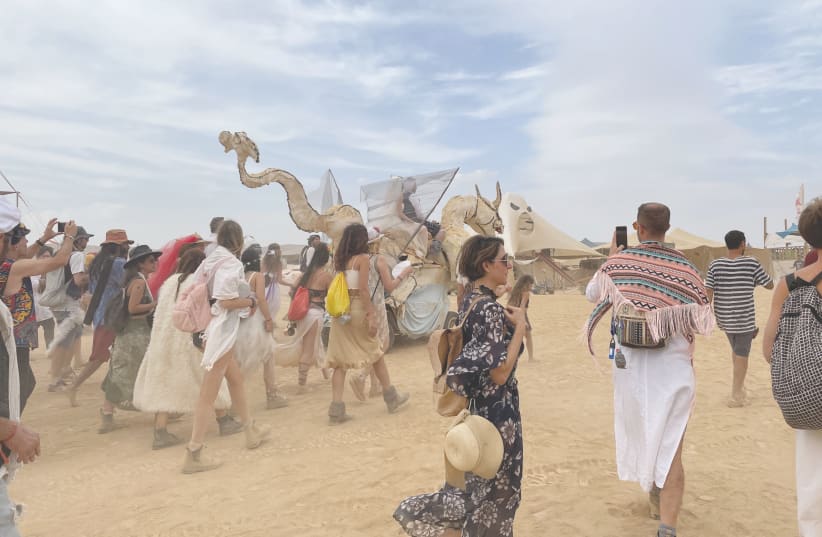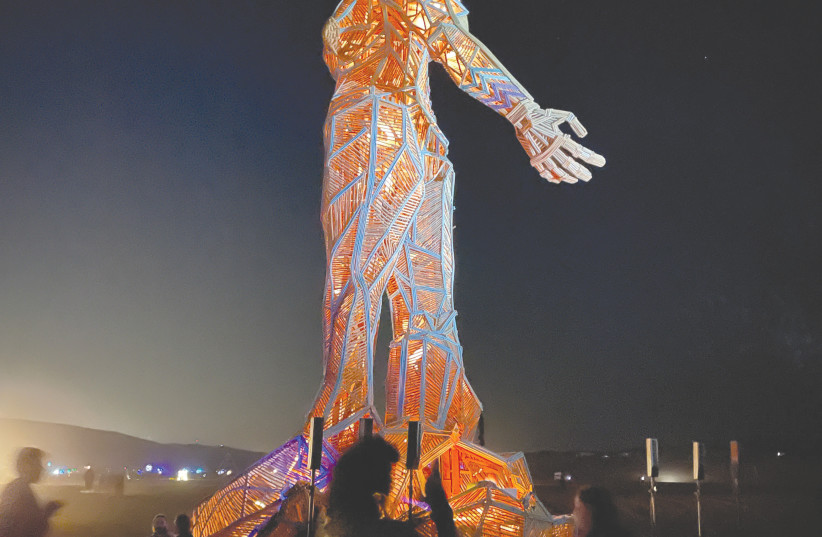Nine camping sections, 5,000 people, 120 art installations and larger-than-life wooden structures burned to the ground. That was this year’s Midburn.
The Negev desert event is Israel’s rendition of the Burning Man event, which takes place annually on the West Coast of the United States and has been running since 1986.
The five-day event, which took place last week near Arad, is an interactive experience where groups of friends band together to create mini campsites that offer other camp-goers an experience. No money is ever exchanged. Instead, people share their resources and find fun through bartering.
The highlight of the event is the effigy, a classic part of Midburn culture. Artists create enormous humanlike wooden structures and then burn them down to the ground before everyone’s eyes. Multiple structures are burned down during the course of the event. Many participants reported the burning of the effigy felt like a metaphor. Something beautiful and larger than life can still be so easily destroyed.
The first Midburn took place in Israel in 2014, but between difficulty in finding an appropriate space and then two years of Covid cancellations, Midburn 2021 finally happened after three-and-a-half years in the making.
This year there were a number of interesting camps with attractions for “burners.” One camp created a ride called the Moonwalk, which raised two people into the air and simulated what it might feel like to walk on the moon. Another ran a cabaret club where campers performed shows and served cocktails. There was even a Palestinian camp, where members brewed guests coffees and offered spanks “for the occupation.” A bit risqué, but all in good fun according to the camp’s head organizer.
“People have been having a good laugh and begging for more,” said the Palestinian camp leader. He wished to remain unnamed out of fear of being accused of collaborating with Israelis. “The humor allows people to talk.”
One of the 10 principles of Midburn includes “radical self-expression,” and many times that can extend into nudity, sexual representations and, for many, drug use.
This year’s Midburn was pushed back a month after government officials said COVID-19 numbers were too high to stage such an event.
Organizers said planning the event during the uncertain and ever-changing period of Covid was so stressful that some organizers dropped out, preferring not to spend their efforts working on an event that could be closed down at any minute.
“They worked on the effigy for three months, every day, and they didn’t know if it was going to happen in the end or not. And there wasn’t a burn in Israel for three years, so it’s pretty crazy that all the artists took a risk that it [their installations] wouldn’t have a home,” said Judy Hazan, a volunteer media liaison and longtime Midburner.
Israel’s last Midburn had 13,000 participants, including 800 tourists from around the world. It is the third-largest of its kind and is a recognized branch of the Burning Man community. This year, with Israel permitting only 5,000 per outdoor event, ticket prices were beefed up by around NIS 250 to compensate for the lack of heads.
In the middle of the event, the government announced that all restrictions for open-air events had been removed. The ruling, which was pushed forward by Culture and Sports Minister Chili Tropper, is thought to have been promoted in an effort to include as many runners as possible in the Jerusalem Marathon, which fell out on the last day of Midburn. The news spread fast, with frustrated burners discussing it in every corner of the mini-city.
“I just heard in the news that the restriction of 5,000 is getting canceled. That’s funny. A bit disappointed because we could have had more friends here and people. But, on the other hand, we had Midburn,” said Ayelet Mizner, a PR rep for Midburn.
THIS YEAR’S “Playa” (an expansive desert area on the grounds) housed 120 art installations entirely created by enthusiastic burners. The theme of the event this year was “Return,” in an effort to highlight Midburn’s comeback after having been on hold. Artists were able to choose if they wanted to create something with that idea in mind or do something completely original.
“The fact that 5,000 people put this amount of stuff together in a period when there was less money than ever to give to art... that was incredible,” Danna Colin said.
In addition to being an original Israeli burner, Colin also volunteers on the board for art grants. She says this year the committee saw more requests for cash than ever before. The team worked through double the number of grant requests than they had a budget to fulfill and ended up granting NIS 300,000.
A patch of empty desert outside of the camps played host to colorful art installations, lights, structures, places to sit and even life-size instruments that are meant to be played. The Playa is a place for adventure. The idea is to explore the sites and get lost in the artwork with friends. Many of the installations are lit up, which offers a different experience by night.
“My favorite parts are cruising around the Playa, watching the sunrise and sunset and the sunrise and sunset again... and dancing,” said Anat Cohen, who spoke to The Jerusalem Post at an 8 a.m. dance party.
Though a Midburn ticket costs money, the entire event is run by volunteers, and many translate their skills into useful Midburn community needs. Nurses and doctors who join the event often take a shift working in the pop-up Midburn clinic, while lawyers and counselors might offer to sit in a tent set up to provide a safe space for people who report they have been sexually violated on the premises.
“You see people here who have really demanding jobs. We have a commander in the army, some people run tech companies or are teachers, and they find the time to do the art. Every sign you see – someone created it,” said Ayelet Mizner, a PR rep for Midburn.
Midburn ended Friday, and by Saturday people were packing up and heading home. As burners came back online, social media flooded with photos of participants showing off their costumes.

